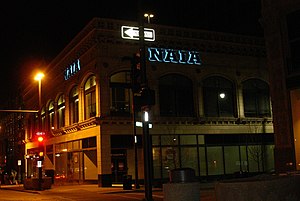 PAL's third logo was applied to aircraft during the 1970s, in concurrent use with the second one. The typeface used here was later applied to the second logo. (Photo credit: Wikipedia)
PAL's third logo was applied to aircraft during the 1970s, in concurrent use with the second one. The typeface used here was later applied to the second logo. (Photo credit: Wikipedia)
Diversified conglomerate
San Miguel Corp. (SMC) jacked up its net income 31 percent in the first half to P14.1 billion, powered by strong performance across most of its businesses.
In a financial report released yesterday, SMC said its revenues grew 25 percent to P329.5 billion although
operating income slid 20 percent to P25.1 billion on increased prices of crude oil and
raw materials.
Despite the rise in input costs for some of its businesses, SMC chairman and chief executive officer Eduardo M. Cojuangco Jr. said the group’s highly-diversified portfolio provided fresh growth drivers that allowed them to deliver good results.
“Our first semester financial results provide a glimpse of the importance of a diversified portfolio and the continuing value of our core businesses to the overall stability of the group,” Cojuangco said.
Consolidated recurring
earnings before interest, taxes, depreciation and amortization (EBITDA) amounted to P38.4 billion.
Flagship firm
San Miguel Brewery Inc. turned in revenues of P36.9 billion, four percent higher than a year ago, with the brewery’s international operations registering double-digit revenue growth as a result of higher volumes in
Hong Kong, Indonesia and Thailand. Consolidated operating income rose six percent to P10.8 billion.
Hard liquor unit Ginebra San Miguel Inc., on the other hand, reported a 12 percent drop in revenues to P7.2 billion as sales volumes declined by 15 percent to 11.7 million cases. As a result, it recorded an operating loss of P157 million.
San Miguel Pure Foods Co. Inc. continued its upward traction with net sales improving seven percent to P45.3 billion on strong showing of the agro-industrial cluster, value-added meats and milling segments.
Higher raw material prices and limited supply of cassava in the earlier part of the year weighed down on its operating income, which was at P1.9 billion in the first semester. However, the second quarter improvements in the pork and chicken supply-demand scenario and raw material prices almost doubled its operating income to P1.2 billion from P659 million in the first quarter.
Meanwhile, revenues from the San Miguel Packaging Group slightly decreased to P11.9 billion, weighed down by the lingering global economic crisis. Operating income, however, improved five percent to P1.1 billion.
With better utilization of all plants and increased demand from bilateral customers, SMC Global Power’s consolidated net revenues went by 11 percent to P39.5 billion, resulting in a 17 percent rise in operating income to P8.8 billion.
Its net generation volume for the first semester reached 8,081 gigawatt hours, up 12 percent.
Net earnings of its major sales contributor,
Petron Corp., slid 93 percent to P432 million due to the volatility in global oil markets and the consolidation of its Malaysian operations. It completed the purchase of Esso Malaysia Bhd. in March. Excluding the second-quarter loss of the Malaysian business, Petron posted a net profit of almost P2 billion in the first semester.
The oil industry saw a steep and continuous decline in crude and finished product prices from April to the first week of July, which resulted in 13 weeks of consecutive price rollbacks in local pump prices. Margins also narrowed as higher cost inventory were sold at lower prices. But while margins were contracting, Petron’s total domestic sales expanded nine percent 21.81 million barrels.
In other businesses, SMC said its infrastructure projects are progressing as planned and it expects revenues to come in by the first quarter of 2013.
Philippine Airlines (
PAL) also recently took delivery of its third long-haul
Boeing 777-300 ER. PAL has also started implementing its new growth strategy that includes the modernization of its fleet, the expansion of its network, and improvements in passenger service. Looking forward, the airline has several initiatives in place aimed at increasing profits by generating revenue growth and controlling costs.
“Across the San Miguel Group, we will be working hard to harness potential synergies from recent acquisitions and new businesses so that markets can be developed, revenue streams can be increased, costs can be reduced, and efficiency improved,” Cojuangco said.
http://www.philstar.com/Article.aspx?publicationSubCategoryId=66&articleId=837747
 Japanese money supply (April 1998 - April 2008) (Photo credit: Wikipedia)
Japanese money supply (April 1998 - April 2008) (Photo credit: Wikipedia)

























